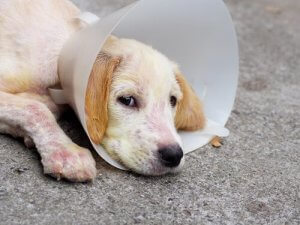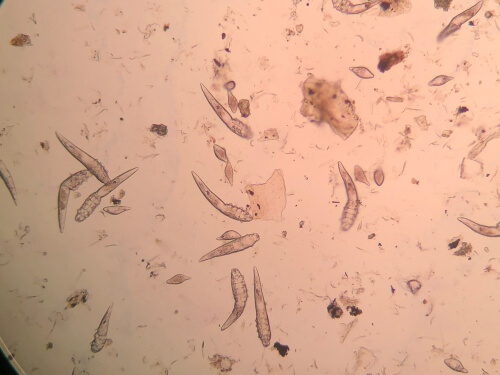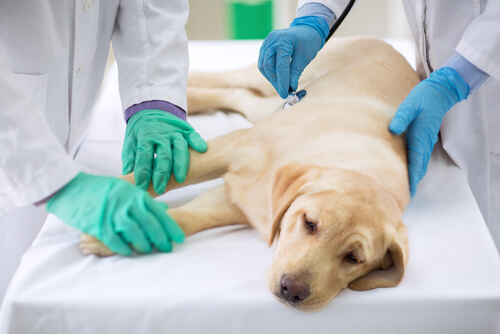How to Treat Demodectic Mange in Dogs


Written and verified by the biotechnologist Alejandro Rodríguez
When they hear the word demodicosis, people might think that it sounds like some really serious and highly contagious disease. However, demodectic mange (also known as canine demodicosis or red mange) is actually a relatively common complaint, and, in most cases, is easily treatable. In this article, we’ll tell you all about the causes, diagnosis, and treatments that are available.
What causes demodectic mange?
The cause of this condition is the Demodex mite, more specifically the genus Demodex Canis. These microscopic creatures live in the hair follicles of many species of mammal.
These mites are not uncommon on our four-legged friends. However, in most cases, the dog’s immune system is able to keep their numbers to a minimum.
If, for whatever reason, (such as immunodeficiency) the mite population starts to get out of control, it can turn into an infestation. This infestation can cause significant damage to your pet’s skin and, if left untreated, can eventually lead to demodectic mange.

Symptoms of demodectic mange
Demodectic mange can affect dogs of all ages. Localized demodicosis usually affects puppies and dogs under two years of age. The most common symptoms include hair loss and skin inflammation, mainly on the head and paws.
Your pet will likely suffer from pruritis, which is the medical way of saying intense and constant itching. This variety of mange is fairly mild, and usually gets better by itself with time.
Generalized demodectic mange, on the other hand, can be very serious, and affects adult dogs. It can start to spread all over the body, and can even affect their claws and the pads of their paws.

In this case, the skin lesions are more serious, and can even develop into deep, festering wounds. All these symptoms are usually accompanied by a fever, general discomfort, and incessant licking of the affected areas.
Diagnosis
Fortunately, the diagnosis of demodectic mange is pretty straightforward. A vet will simply take a skin scraping from your dog to confirm the presence of Demodex mites. Normally, they will take a sample from the most affected areas to get a more accurate diagnosis.
At this point, we feel it’s important to emphasize that if you notice any of the above symptoms on your pet, you should take it to a vet so that they can start treatment as soon as possible.
Treatment of demodectic mange
Because it can lead to a number of secondary infections, treatment of demodectic mange can vary. Whether it is a localized or generalized variety will also have an impact on the prescribed treatment plan. Although localized demodicosis usually disappears with time, your vet may prescribe medical shampoo along with an antiparasitic to help clear the infestation.

If your pet is suffering from generalized mange, a vet will often suggest an amitraz bath. This antiparasitic can help relieve symptoms, but also has a number of adverse side effects.
As many animals suffer from a chronic form of demodicosis, the products that are usually used to treat animals are mainly designed to relieve symptoms. The actual cause of the condition is normally attributed to a compromised immune system.
It’s important not to interrupt treatment once started, and to check your pet regularly to make sure that the number of mites has decreased. Because preventing demodectic mange is fairly difficult, it’s important to make sure your pet has a great quality of life: healthy diet, daily exercise, and lots of love and attention.
Finally, it’s important to reiterate that if you have any doubts or concerns about your dog, your vet is always the best person to talk to.
When they hear the word demodicosis, people might think that it sounds like some really serious and highly contagious disease. However, demodectic mange (also known as canine demodicosis or red mange) is actually a relatively common complaint, and, in most cases, is easily treatable. In this article, we’ll tell you all about the causes, diagnosis, and treatments that are available.
What causes demodectic mange?
The cause of this condition is the Demodex mite, more specifically the genus Demodex Canis. These microscopic creatures live in the hair follicles of many species of mammal.
These mites are not uncommon on our four-legged friends. However, in most cases, the dog’s immune system is able to keep their numbers to a minimum.
If, for whatever reason, (such as immunodeficiency) the mite population starts to get out of control, it can turn into an infestation. This infestation can cause significant damage to your pet’s skin and, if left untreated, can eventually lead to demodectic mange.

Symptoms of demodectic mange
Demodectic mange can affect dogs of all ages. Localized demodicosis usually affects puppies and dogs under two years of age. The most common symptoms include hair loss and skin inflammation, mainly on the head and paws.
Your pet will likely suffer from pruritis, which is the medical way of saying intense and constant itching. This variety of mange is fairly mild, and usually gets better by itself with time.
Generalized demodectic mange, on the other hand, can be very serious, and affects adult dogs. It can start to spread all over the body, and can even affect their claws and the pads of their paws.

In this case, the skin lesions are more serious, and can even develop into deep, festering wounds. All these symptoms are usually accompanied by a fever, general discomfort, and incessant licking of the affected areas.
Diagnosis
Fortunately, the diagnosis of demodectic mange is pretty straightforward. A vet will simply take a skin scraping from your dog to confirm the presence of Demodex mites. Normally, they will take a sample from the most affected areas to get a more accurate diagnosis.
At this point, we feel it’s important to emphasize that if you notice any of the above symptoms on your pet, you should take it to a vet so that they can start treatment as soon as possible.
Treatment of demodectic mange
Because it can lead to a number of secondary infections, treatment of demodectic mange can vary. Whether it is a localized or generalized variety will also have an impact on the prescribed treatment plan. Although localized demodicosis usually disappears with time, your vet may prescribe medical shampoo along with an antiparasitic to help clear the infestation.

If your pet is suffering from generalized mange, a vet will often suggest an amitraz bath. This antiparasitic can help relieve symptoms, but also has a number of adverse side effects.
As many animals suffer from a chronic form of demodicosis, the products that are usually used to treat animals are mainly designed to relieve symptoms. The actual cause of the condition is normally attributed to a compromised immune system.
It’s important not to interrupt treatment once started, and to check your pet regularly to make sure that the number of mites has decreased. Because preventing demodectic mange is fairly difficult, it’s important to make sure your pet has a great quality of life: healthy diet, daily exercise, and lots of love and attention.
Finally, it’s important to reiterate that if you have any doubts or concerns about your dog, your vet is always the best person to talk to.
All cited sources were thoroughly reviewed by our team to ensure their quality, reliability, currency, and validity. The bibliography of this article was considered reliable and of academic or scientific accuracy.
- Sivajothi, S., Reddy, B. S., & Rayulu, V. C. (2015). Demodicosis caused by Demodex canis and Demodex cornei in dogs. Journal of parasitic diseases, 39(4), 673-676.
- Saló, E. (2011). Formas clínicas de la demodicosis canina. No todo son alopecias. Clínica veterinaria de pequeños animales: revista oficial de AVEPA, Asociación Veterinaria Española de Especialistas en Pequeños Animales, 31(1).
- Fondati, A., De Lucia, M., Furiani, N., Monaco, M., Ordeix, L., & Scarampella, F. (2010). Prevalence of Demodex canis‐positive healthy dogs at trichoscopic examination. Veterinary dermatology, 21(2), 146-151.
This text is provided for informational purposes only and does not replace consultation with a professional. If in doubt, consult your specialist.








